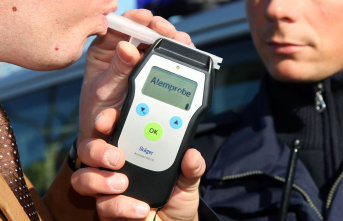When there is noise in their environment, dolphins increase the volume and duration of the whistles they use to communicate. Despite these attempts to compensate, the marine mammals' communication can be significantly impaired by loud noises, reports a team led by Pernille Sørensen from the University of Bristol in Great Britain.
Dolphins communicate with each other using various underwater sounds. However, if the animals are in a particularly noisy environment, they even have to "scream" to communicate. The results, published in the journal Current Biology, show how underwater noise can affect the lives of dolphins.
Communication is essential for survival
Dolphins are social animals that live together in so-called schools. They protect each other, raise young animals together, hunt prey together and play together. To do this, they produce, among other things, whistles and clicks for echolocation. The exchange of information with their group members, for example when hunting or mating, is essential for the survival of both the individual and the population.
However, the underwater communication of marine mammals is increasingly being disrupted by humans. Underwater drilling or shipping generate a lot of noise, which means that the animals can no longer communicate normally and cannot coordinate complex behaviors properly. Orientation, foraging or the recognition of conspecifics are significantly impaired. In the long run, this can lead to serious behavioral changes, damage to health and even an increased risk of death for the animals.
To compensate for the increasing noise pollution, individual animals use their specific calls louder, longer or more often. Or they leave the place to go to quieter areas.
So far, these behaviors have only been demonstrated in single individuals. The international team now investigated how two bottlenose dolphins - a type of dolphin - reacted to increasing noise while they were supposed to solve a joint task.
Dolphins should press buttons underwater when there is noise
The male dolphins, Delta and Reese, were to simultaneously press two underwater buttons located at opposite ends of the experimental lagoon. In previous trials, the duo had already proven that they could solve such a task through precise communication. The new challenge was to complete the task in different background noises – from normal ambient noise to the enormous noise of a high-pressure cleaner.
Result: The success of the bottlenose dolphins decreased with increasing ambient noise. While the two managed to press the two buttons at the same time in normal ambient noise in 85 percent of the attempts, their success rate dropped to 62.5 percent in the strongest noise annoyance.
Dolphins literally had to "scream"
The researchers also observed that the dolphins increased both the volume and duration of their whistles as the noise level increased. The animals literally had to "scream" to coordinate themselves. At the noise of the high-pressure cleaner, they whistled almost twice as long as usual. The animals also changed their body language: as the noise increased, they reoriented themselves more often to one another and swam to the opposite side of the lagoon in order to get closer and get a better signal from their partner to be able to understand. "Our study shows that the dolphins' communication is significantly impaired by the noise - despite their various attempts to compensate," said first author Sørensen.
Although the study was only carried out on dolphins in human care, the researchers assume that man-made noise also affects wild dolphins. "For example, background noise could make foraging less efficient together," said co-author Stephanie King (also from the University of Bristol). "This not only harms the health of individuals, but ultimately the entire population."











